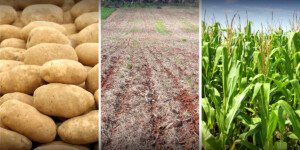Ask yourself this. Would you really want to be on the other side of a trade dispute with the USA? With all the hysteria over tariffs, that’s a question few seem to be asking. In the global economy, the good ole USA remains the 700-pound gorilla. Boasting a GDP over $25 trillion, the US economy is nearly 50% greater than the runner up (China).
All this economic might create a whole lotta purchase power. At a world-leading $3.17 trillion annually, the USA accounts for more than 13% of all world imports, leaving every nation itching to get in on the American consumer. And the Yanks have expensive tastes. US imports include an array of luxury items, including high-value ag products. We import 20% of the world’s coffee ($8.2 billion) and also lead the world in imports of avocados ($3.3B), wine ($6.19B) and flowers ($2.48B). Most business negotiations come down to who needs who more. And the leverage appears to be on the side of the red, white and blue. But from a short-term microeconomic perspective, it’s easy to understand the angst among producers who rely on these markets. Trade-reliant products such as soybeans and pork could see prices drop due to retaliation. And Mexico is the USA’s biggest corn customer. Then there’s the effect on crop inputs. Canada is the world’s leading producer of potash, supplying US farmers with about 90% of their potash. Unless there’s an exemption, American farmers can expect to pay more for the macronutrient. From a macroeconomic perspective, tariffs are just one spoke in the wheel. There are several pieces to growing an economy. Lowering energy costs, cutting government spending, lowering regulations and cutting taxes all drive economic growth. So does driving demand for home-grown production. As of Saturday, the USA imposed 25% tariffs on Mexico and Canada: 10% on China. Both neighbors appear to be in the process of retaliating. But is that something they really want to do? Especially when both already benefit from a trade surplus. Collectively, these neighbors comprise about one-third of total USA exports. That’s certainly significant, and it will be felt by producers and consumers alike. But it pales in comparison to the grip American consumers have on their economies: 77% of Canada’s exports (accounting for 17% of its entire GDP) go to the USA; nearly one-third of Mexico’s total GDP (84% of its total exports) is based on exports to the USA. Given these numbers, the North American trade dispute may not last too long.
Update: to show how quickly things can change in today’s geo-political climate, tariffs on both Mexico and Canada have been paused, as trade negotiations continue.
Climate change is changing. From the USDA vernacular, that is. Last week USDA stripped all references of climate change from its web sites. This sends a clear message from the new administration regarding their stance on a very polarizing issue. It also invites lots of questions for the ag industry. How will programs and policy, created in the name of climate change, be impacted? What will become of the 45z tax credits, passed by the previous administration? The legislation that opened potential new revenue streams for biofuel producers and subsequently, the growers they source from. The debate around man-made climate impact will no doubt rage on. But one thing’s clear, this shows that words matter. The term climate change continues to be a lightning rod, and its removal will be welcomed by many farmers. Regardless of their region or political beliefs, the overwhelming majority of farmers are stout conservationists. Most live on the land they live off. Drink the water below the fields they farm. Desire clean air. And their main goal in life is to preserve the land for their descendants. Unfortunately, the term climate change has become toxic, hijacked by many of the activists who support it. Concerns over greenhouse gas emissions, no matter how well intended, have transcended into absurd claims about cow farts and finger pointing by celebrities from their private jets, while excessive regulations and higher taxes are presented as the main cures. All while China builds new coal plants every week. Like it or not, that’s how many farmers see it. Agriculture, and farmers specifically, can remedy many issues impacting soil, air and water, while still sustainably feeding the world. Most are excellent stewards of the environment and are open to improvements that are eco-friendly and economically friendly. That’s where the narrative must shift.
How’d you like to be Brooke Rollins right now? You’ve yet to receive Senate confirmation as new USDA Secretary before receiving last week’s news on tariffs, trade and climate. Also awaiting you is a recently approved $10 billion economic aid package to disperse; an avian influenza epidemic (which has driven up the price of eggs); biofuel programs; and migrant labor issues. Not to mention a very challenging ag economy. Should make for an eventful first week.
Twelve years ago this Sunday, the greatest Super Bowl ad of all time was presented by Dodge Trucks. It honors the world’s greatest profession. And it still gives goosebumps. Enjoy “God Made a Farmer.”
Related Posts

This Week in Ag #26

This Week in Ag #3
There are lots of definitions floating around for regenerative agriculture. But the best and simplest I’ve heard was from Soilcraft. They define regen ag as adding “life.” When you think about it, the practices of no-till/low-till, crop rotation, cover crops, manure and biological products all help create, stimulate, prolong and accelerate more diverse life in the

This Week in Ag #48
The popular TV series Yellowstone, along with the western lifestyle craze, has certainly romanticized ranching. It seems like everyone wants to be a rancher, until there’s real-world ranching stuff to do. This week’s bone-chilling Midwestern weather brings back memories. Notice I didn’t say fond memories. When you have livestock, they require care every day. Utility tractors

